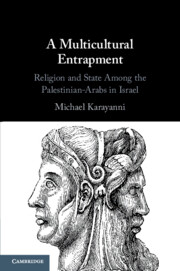Book contents
- A Multicultural Entrapment
- A Multicultural Entrapment
- Copyright page
- Dedication
- Contents
- Preface
- 1 Religion-and-State Conflict in Israel
- 2 The Janus-Faced Religion-and-State Conflict in Israel
- 3 Palestinian-Arab Religious Jurisdiction As an Individual Predicament
- 4 The Acute Nature of the Palestinian-Arab Individual Predicament
- 5 The Individual Predicament As Multicultural Entrapment
- 6 The Voice of No Exit
- Epilogue
- Bibliography
- Index
2 - The Janus-Faced Religion-and-State Conflict in Israel
Published online by Cambridge University Press: 08 January 2021
- A Multicultural Entrapment
- A Multicultural Entrapment
- Copyright page
- Dedication
- Contents
- Preface
- 1 Religion-and-State Conflict in Israel
- 2 The Janus-Faced Religion-and-State Conflict in Israel
- 3 Palestinian-Arab Religious Jurisdiction As an Individual Predicament
- 4 The Acute Nature of the Palestinian-Arab Individual Predicament
- 5 The Individual Predicament As Multicultural Entrapment
- 6 The Voice of No Exit
- Epilogue
- Bibliography
- Index
Summary
Two different constitutional designs govern in matters of religion and state in Israel: one for the recognition accorded to Jewish religious institutions and norms and a second for the recognition accorded to Palestinian-Arab religious institutions and norms. This becomes apparent if we were to look at the recognition accorded to the religious institutions and norms of these communities through the public-private divide and the coercive-liberal divide. The recognition accorded to Jewish religious institutions and norms comes from Israel’s officialdom and is thus part of its public sphere. From the liberal perspective, this recognition is generally perceived as illiberal and coercive in nature. The recognition accorded to Palestinian-Arab religious institutions and norms, however, is part of the private sphere – a minority matter rather than a matter of the state. This recognition is also presented as liberal and even multicultural – the Jewish state is accorded recognition to its non-Jewish minorities in the name of pluralism and toleration. Given this paradigmatic divergence in the nature of the recognition accorded to Jewish versus Palestinian-Arab religious communities, the discussion of the first excludes the discussion of the later. This is the Janus-faced constitutional design of Israeli religion-and-state relations.
- Type
- Chapter
- Information
- A Multicultural EntrapmentReligion and State Among the Palestinian-Arabs in Israel, pp. 42 - 98Publisher: Cambridge University PressPrint publication year: 2020

